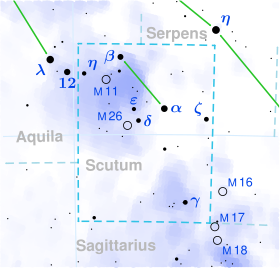Epsilon Scuti
| Observation data Epoch J2000 Equinox J2000 |
|
|---|---|
| Constellation | Scutum |
| Right ascension | 18h 43m 31.252s |
| Declination | −8° 16′ 30.80″ |
| Apparent magnitude (V) | 4.88 |
| Characteristics | |
| Spectral type | G8IIb |
| U−B color index | +0.88 |
| B−V color index | +1.12 |
| Astrometry | |
| Radial velocity (Rv) | -9.80 km/s |
| Proper motion (μ) |
RA: +21.06 mas/yr Dec.: +9.11 mas/yr |
| Parallax (π) | 6.06 ± 0.64mas |
| Distance | approx. 540 ly (approx. 170 pc) |
| Absolute magnitude (MV) | -1.18 |
| Details | |
| Luminosity | 403 L☉ |
| Surface gravity (log g) | 1.00 cgs |
| Temperature | 4,500 K |
| Metallicity [Fe/H] | +0.05 dex |
| Rotational velocity (v sin i) | 5.1 km/s |
| Other designations | |
| Database references | |
| SIMBAD | data |
Epsilon Scuti (ε Sct, ε Scuti) is a star system in the constellation Scutum. It is approximately 540 light years from Earth.
The primary component, Epsilon Scuti A, is a yellow G-type bright giant with an apparent magnitude of +4.88. It has at least three faint companions, two 14th magnitude stars, B and D, separated from the primary by 13.6 and 15.4 arcseconds respectively, and the 13th magnitude C, which is 38 arcseconds away.
Epsilon Scuti was a latter designation of 3 Aquilae.
...
Wikipedia

